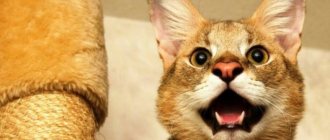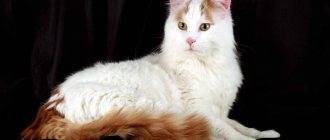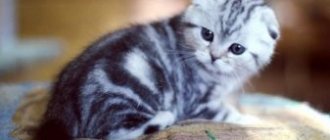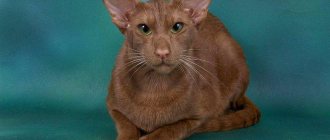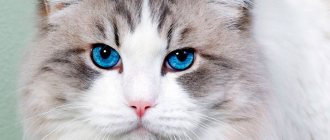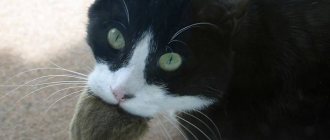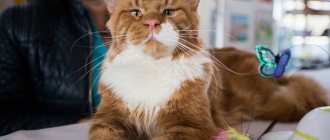Cats of different breeds and colors have a typical appearance: a cute face, a graceful body, slender legs and a long tail. Not all people know that there is a separate category of domestic representatives - tailless cats, unique breeds with an original appearance and friendly character.
In our country, such cats are rare, although every year more and more breeders are inclined to choose tailless breeds. They are especially popular among residents of Japan and China, where, according to popular beliefs and traditions, cats without a tail are a symbol of good luck and prosperity. Would you like to know the story of their origin? Then our article will be interesting and informative for you!
Origin of breed characteristics
Cats with short tails have been known for centuries. Traditions and legends explain the presence of such a deviation in animals in different ways. In the biblical version, the cat that was late for the ark had its tail pressed against the door. An equally common misconception is that kittens are specifically subjected to surgery to obtain a fluffy pom-pom.
Genetics explained that the birth of individuals without the last vertebrae is associated with a mutation on several chromosomes. Due to the fact that most of the short-tailed breeds were bred on the islands in isolated communities, it was possible to quickly obtain numerous offspring of an unusual appearance.
Manx
Japanese branch
In ancient Japanese beliefs, there is a deity called Nekomata. He has the appearance of a cat with two tails and brings troubles, illnesses and suffering to people. When cats arrived in Japan along with merchant ships, the local population began to cut off the tails of their pets so as not to attract the attention of an evil spirit.
Naturally, selection preference was given to those animals whose tails were shorter than those of their relatives. Gradually, most of the cats on the island turned out to be the owners of a neat fluffy pom-pom.
Japanese Bobtail
All breeds with Japanese roots are called bobtails. In the land of the rising sun itself, they are called maneki-neko and are considered symbols of wealth and prosperity.
Since the economic and political isolation of the islands ended, representatives of unusual cats have spread throughout the world. Their genetic characteristics were used to breed tailless hybrids with other common breeds.
Read more in the article about Japanese bobtails.
British branch
Manx cats originated on the Isle of Man, located near Great Britain. The random mutation quickly spread and was fixed by additional selection. Unusual short-tailed cats became a curiosity and a local calling card and quickly spread from there throughout Europe and America. Externally, the animals are very similar to British Shorthairs. The appearance of rare furry offspring was received with great interest by breeders. Subsequently, a separate subspecies of long-haired Manx was even bred in Canada.
Manx
We recommend reading the article about the Manx breed.
There are other local branches that are of South American or Thai origin. The exterior of bobtails and manxes includes 4 different breed variations:
| Name | Length of the caudal process |
| Rampy | Completely absent |
| Reeser | 1-2 vertebrae |
| Stumpy | 4-8 links |
| Longs | A little shorter than usual |
Rampy
Reeser
Stumpy
Longs
Tailless cats: history and their types
Felinologists even today cannot agree on how tailless cats appeared. Several versions have been put forward:
- During research work, scientists have repeatedly confirmed the fact that most wild cats gave birth to ordinary babies, but chewed off the kittens’ tails within 24 hours. It is believed that the instinctive ridding of babies from the “weak spot” eventually led to a natural mutation and the animals became short-tailed.
- A natural mutation without prerequisites such as biting off the tail, which led to short tails.
- The third version applies only to American bobtails and pixie bobs. Many believe that these cats descended from lynxes themselves.
A distinctive feature of all tailless cats is their short tail.
Types of tailings
Conventionally, all tailless cats can be divided into two groups: Manx and Bobtail (except for the Pixie Bob and American Bobtail, whose tails should be as close as possible to a lynx). Each of them has its own tail classifications:
- Manx: Rumpy or Dimple Rumpy are the most highly prized cats. Their tail is completely absent; in the place of its growth there is a small hole. Usually it is cats like rumpy that receive titles at shows.
- Riser or rampy riser - their tail consists of 1-3 vertebrae. Such cats can participate in exhibitions if the tail does not exceed 2–4 cm in length.
- Stumpy - from 4 to 14 vertebrae, often lumpy and knobby.
- Longs or tails. The tail is almost the same length as that of tailed cats. Often the tail has to be docked, since the vertebral discs of long-haired cats can ossify.
- Stump:
- from 2 to 8 vertebrae;
- from 4 to 15 vertebrae;
- consists of 5–11 vertebrae;
- the beginning of the tail (approximately 5–7 vertebrae) is identical in structure to the tail of a simple cat;
Photo gallery: types of tails
Cats with a retracted bobtail do not participate in exhibitions
Cats with a tail (or rather, lack thereof) like rumpy are valued the most
The tail-broom looks like a big fluffy pom-pom
The stump tail is characteristic only of bobtails.
The riser-type tail is almost invisible
A stumpy tail is considered a fault.
The longi tail type is similar to a regular tail.
The spiral tail should be well feathered
Popular tailless breeds
The choice of a kitten is influenced not only by the presence of a cute feature in its appearance, but also by its character, intelligence, and price. Thus, the subspecies that are docile, stable and recognized by international felinological communities are becoming the most popular among owners.
American Bobtail
The progenitor of the breed is considered to be a kitten named Yodi. He was brought from an Indian reservation and, due to the fact that the gene for a short tail turned out to be dominant, they quickly received numerous offspring with the same feature.
For many years, breeders crossed Ragdolls, Manxes, Siamese and mongrel cats with Indian Bobtail offspring to create a unique breed. In the nineties of the twentieth century, it was recognized as an independent breed.
These are strong, muscular animals with dense thick fur. They have a friendly disposition, allowing pets to quickly learn and adapt to family life.
Also read the article about American Bobtails.
Japanese Bobtail
These are direct descendants of short-tailed cats bred in the land of the rising sun. It’s not without reason that miniature cats with shiny, smooth fur and a gentle character have become a symbol of well-being in Japanese families.
They are calm, clean, affectionate and become close friends to their owners and first helpers in the fight against stress.
Mekong Bobtail
The breed was bred in Russia. Kittens with unusual tails were brought from Siam (Thailand), with which our country has long-standing trade and economic ties. Breeders paid a lot of attention to preserving the exterior and original color of the animals.
Thanks to the efforts of breeders, Mekong cats are distinguished by bright blue eyes and a characteristic colorpoint color. Representatives of the breed do not have two similar tail shapes. They are almost as unique as fingerprints.
It differs from other breeds in its longer life expectancy. Animals are known to be 25 years old or more.
Miniature and cute pets will become faithful companions to their owners. They appreciate attention, affection and care.
Read the article about Mekong Bobtails.
Kurilian Bobtail
These cats were bred by crossing Japanese bobtails with wild inhabitants of the Kuril Islands of the Russian Far East. Fluffy, lush pom-pom tails and forest coloring, as well as piercing yellow or green eyes, have become a characteristic feature of the breed.
Breeders call them cats with the personality of a dog because of their incredible loyalty to their owner. They can defend it quite aggressively from strangers. Kurils are very active and curious, they love active games.
More about Kurilian Bobtails.
Karelian Bobtail
Representatives of the breed were the result of selection of short-tailed pets with a wild Norwegian cat. These are furry animals with an incredibly friendly and loving disposition.
At the moment, the subspecies is considered quite rare, although it has been known since the mid-eighties of the twentieth century. Karelians are very clean and hardly mark their territory.
Manx
This variety often produces kittens with the usual long tail. Most individuals have several vertebrae, and their complete absence is rare. Rampy cats are very rare. This is due not only to the low probability of their birth, but also to the fact that adult absolutely tailless individuals are often sterile.
Their few offspring are born with serious pathologies and rarely survive. Representatives of the breed have a calm character, they are clean and intelligent.
Cymric
These are long-haired descendants of short-tailed cats from the Isle of Man. Welsh cats do not have a tail at all, but they can give birth to completely normal kittens.
For several years, work has been underway to designate the Cymric as a separate breed, but for now official associations recognize them as long-haired Manx.
Read the article about the Cymrics.
Pixiebob
Cats of this breed look like miniature lynxes. Protective natural coloring, short tail, developed muscles and excellent hunting qualities make pixiebobs ideal partners for active games and walks.
Individuals are characterized by polydactyly - the appearance of additional fingers. Because of this feature, their paws look larger. They were bred in the USA, where they are considered national pride and heritage.
Read the article about pixiebobs.
Health Features of Tailless Cats
In general, tailless cats are in good health: they rarely get colds and are not susceptible to heart disease or infections. But some risk areas are still present.
Bobtails are susceptible to some diseases, but they rarely occur.
Diseases and defects
Genetic diseases are unfamiliar to tailless cats, but acquired ones occur due to the structure of the body and the characteristics of the organism:
- Proctitis (inflammation of the anus) occurs due to the structure of the tail, under which dirt and fecal particles can accumulate, leading to inflammation. It is treated with medications or surgery, depending on the severity and depth of spread.
- Urolithiasis disease. Mostly, Kurilian and Karelian bobtails get sick due to the different acidity of their urine. If your pet frequently urinates bloody urine, experiences pain when going to the toilet and refuses to eat, this is a sure sign of illness. Stones are removed surgically.
- Manx syndrome, or Manx syndrome. Manx and Cymric cats are susceptible to it. In the first 4 months of life, tailless kittens may develop abnormal spine development. This is followed by spina bifida, hernia, difficulty moving and other problems. The defect cannot be treated.
- In general, tailless cats are prone to spinal problems such as lordosis. But, fortunately, they happen rarely.
A feature of all tailless cats is their elongated hind legs (always longer than the front ones). They developed this unusual feature to maintain body balance without a tail.
Hybrid breeds
Sometimes, in order to obtain healthy and viable offspring, breeders resort to crossing short-tailed individuals with breeds that are suitable in appearance. Many of the resulting hybrids have not yet received official recognition, although they have characteristic features recorded in several generations.
Perhaps in the near future the right to be considered an independent breed will be given to:
- Toy Bob, a miniature blue-eyed cat bred in Russia, with a special Siamese coloring.
- The Oohee Bob is the result of crossing a Manx with a Siamese. They are characterized by color-point or bicolor colors. They inherited their character from their Asian ancestors. This is a self-sufficient, smart cat.
- Snow bob is a short-tailed subspecies with a snow-white color.
- Twisties, which are now being actively bred in the US state of Texas. The animals have short front legs and very long hind legs. According to the description, the cats are similar to tailless kangaroos.
- Oriental Bobtail, in which British breeders want to combine the exotic appearance of Orientals and the complete absence of tail vertebrae.
Types of tail deformation
Tail deformation can be of several types; the most common are kinks, kinks and bends. When a bend occurs, the next vertebra of the tail rises above the previous one, resulting in the formation of a “step up the ladder.” Deformed vertebrae differ in size and have rounded edges.
The opposite defect is a fracture, in which the vertebrae are located “step down”.
The bend is clearly visible to the naked eye; it seems that several vertebrae have “jumped out” beyond the imaginary line that runs through the middle of the vertebrae from the base to the tip of the tail. The bodies of the protruding vertebrae often have a wedge-shaped shape.
Content Features
In general, caring for short-tailed cats is not very different from general grooming requirements. The only nuance is the need for washing with special products approximately once every two weeks. After water treatments, your pet’s fur coat should be thoroughly combed with special combs or a furminator.
We must remember that, regardless of breed, these are very active cats that need intense physical activity. They make ideal playmates for children.
Bobtails appreciate attention, are sociable and are ready to spend all their time in the company of their owners. They are rarely and reluctantly left on their own, they get bored and may even get sick.
Representatives of bob-tailed cats tend to have poor health. They need a balanced diet rich in micronutrients. It may take a long time to find the right diet. Read about how to choose the right diet for your cat on our portal.
It is important to maintain contact with the supervising veterinarian and conduct timely examinations and vaccinations.
If the animal is not suitable for further breeding, it must be sterilized.
American Bobtail
American Bobtail breed history: The American Bobtail was bred in the USA in the 50s. XX century. The ancestor of the cat breed was the cat Yodi with a short bob tail, selected by enthusiastic felinologists on an Indian reservation in Arizona. At first they tried to breed this cat with Siamese cats to get a color point color. However, the offspring obtained as a result of such matings turned out to be non-viable. Then they began to breed the cat with cats of other breeds, and everything worked out.
The first American Bobtail standard was created in 1970, and in 1989 the breed was recognized by TICA.
American Bobtail Personality: American Bobtails are intelligent, sociable, active and unobtrusive.
The American Bobtail has shorthair and semi-longhair variations.
Mr. Cat recommends: the character of cats without a tail
Bobtails, Manx cats and their numerous descendants are very smart and curious, natural hunters, who love to climb and jump.
Their behavior can be compared with dogs. Short-tailed pets can spend the whole day with their owner, following on his heels. Cats need attention and communication; they always respond to calls, are empathic and attentive to the well-being and mood of family members. Pets get along well with children and other animals, but they show a genuine hunting interest in birds and rodents.
The animals are very clean and quickly get accustomed to the scratching post and tray. Even non-sterilized individuals rarely mark territory.
Reasons why cats have their tail docked
Typically, felines have the body part in question amputated for medical reasons.
Fracture
Occurs due to mechanical injuries, such as a fall from a height, being pinched by a door, a sharp jerk, a blow to the back of the body, being hit by a car, or a fight with other representatives of the fauna.
Characterized by a change in appearance. Part of the ponytail is unnaturally curved. Tissue swelling is observed. The animal does not tolerate touching. Shows aggression. He rushes from side to side, or, on the contrary, lies indifferently. Sometimes he cannot move the broken organ.
There are three types of fractures. Closed (damage to the vertebrae without compromising the integrity of muscle tissue and skin), open (bones stick out), fractures (more often occur in kittens, due to skeletal weakness). The vertebrae at the caudal end are able to heal on their own. In the event of such misunderstandings, street cats manage without veterinarians.
A broken tail must be removed
If the wound is located at the base and is open, one operation is not enough for recovery without amputation.
Delay in removing the tail leads to paralysis of the hind limbs, dysfunction of urination and defecation.
Dislocation
Dislocation is a partial displacement of the vertebrae. Symptoms are similar to those of a closed fracture. Uncharacteristic bending of the limb, tissue swelling, aggression.
It is not possible to identify a valid diagnosis on your own, so the patient must be immediately shown to a doctor.
Cupping in case of dislocation is used when reduction is impossible, as well as late presentation to the clinic, when other treatment is impossible and the patient’s life is in danger.
Violation of tissue integrity
Wounds caused by piercing, cutting, squeezing and crushing objects are striking and do not require additional diagnostics.
At the same time, self-medication leads to irreversible consequences (inflammation affecting the spine or tissue death), which requires rejection of the affected area.
It is also recommended to remove the wounded tail
Neoplasms
Lumps, growths, and swelling cannot be delayed and require prompt examination.
A malignant tumor, suppuration, a place where parasitic insects are located - these uncharacteristic manifestations require immediate treatment.
Cupping is carried out when it is impossible to remove the immediate lesion, and in case of cancer it is mandatory.
Defects
In litters of both purebred and barn cats, babies are born with curved tails (looks to the side, has creases or a hook-like shape).
Significant curvature spoils the appearance. It interferes with manipulation of the mutilated part and movement in general. Cupping is shown here.
Crooked tails of purebred animals are usually removed
Purchase
Breeders divide a litter of kittens into three categories:
- Pet – for home keeping, without the possibility of further reproduction. These animals are considered culls and are worth much less than their brothers and sisters.
- Show - babies with pronounced exterior qualities, suitable for participation in exhibitions.
- Breeds are not only visually ideal animals, but also have an impeccable pedigree. These are cats that are subject to further breeding to increase the population and improve the breed.
When choosing a kitten, you should clearly understand whether in the future there will be resources for maintaining the breed and participation in exhibitions and breeding events of the nursery, or whether you just want a special pet for the family.
Next, you need to contact a cattery or breeder community and possibly wait in line for a suitable kitten. During this time, it will be good to prepare for accepting a new family member.
Like any baby, he will need toys, a potty, special grooming products, food and dishes.
Already from the age of five weeks you can get acquainted with a kitten, but it is better to take it home after two or three months, when it finally gets stronger and goes through the first stages of vaccination.
If participation in exhibitions and breeding of purebred cats is a priority factor in choosing a pet, you should carefully study the documents of the parent couple and the status of the nursery.
The kitten itself should have clean ears and eyes, active, strong, without symptoms of inflammation or injury. The fur of a healthy baby is visually and to the touch smooth and well-groomed, without bald spots.
The healthy body weight of a two-month-old kitten is about a kilogram, unless we are talking about miniature varieties. Excess weight may indicate poor nutrition or serious metabolic disorders.
There is no need to rush into choosing a breed and a specific animal. It is important to consciously assess the strengths and capabilities, the readiness of family members to accept a pet and participate in its upbringing.
Haste in buying a pet often becomes the reason why the animal is returned to the breeder or ends up on the street.
Caring for tailless cats
Tailless cats do not require special care. However, owners should remember a few nuances:
- Tailless cats are prone to infections of the anus and may have difficulty going to the toilet, so the owner should not only closely monitor the well-being of the pet on the tray, but also wipe the cat’s area around the anus after each visit to the tray;
- care for the coat of these cats varies depending on the variety (long-haired/short-haired): each cat will need a rubber brush, a combination comb, a furminator and a bristle brush; short-haired dogs are combed 2 times a week (during the molting period - 4-5 times and 1 time with a furminator), long-haired dogs - 3-4 times a week (during molting - every day and once with a furminator);
Tailless cats are easy to care for
- Regular cleaning of the ears (every 5 days) and daily wiping of the eyes with a natural damp cloth are mandatory, as is trimming the nails.
Karelian Bobtail (Karelo-Finnish cat)
Karelian Bobtail breed history: The Karelian Bobtail is a Russian native cat breed and should not be confused with the Kurilian Bobtail.
Karelian short-tailed cats appeared on the Ladoga and Karelian islands (skerries), apparently as a result of a natural mutation. It is believed that the Norwegian Forest Cat took part in the formation of the breed.
In 1994 the breed was recognized by the WCF, but is still considered very rare.
Karelian Bobtail character: Karelian Bobtails are affectionate, smart and obedient, and they also prefer to live in a team (pride).
There is a short-haired variation of the Karelian Bobtail.
Application
The American Ringtail is a friendly pet, suitable for families with both children and elderly people. Cats of this breed easily find a common language with every person and make contact. They are extremely rarely aggressive. They love to engage in dialogue, responding to their owners’ remarks. The cat is affectionate and sociable.
Manx
Manx Breed History: The Manx is an indigenous breed that was the result of a natural mutation that occurred on the Isle of Man in the Irish Sea. This mutation completely deprived cats of their tails.
Manxes are one of the oldest recorded cat breeds. They received their recognition already in 1920.
Manx character: Manx are friendly, playful and not at all aggressive.
Pixie bob (pixie bob, pixie bob)
Pixie-Bob history of the breed: In 1985, an American felinologist from Washington state, Carol Ann Brewer, acquired a large polydactyl cat with spotted hair and short hair, and a year later she picked up a similar male without polydactyly on the street. This cat mated with a mongrel spotted cat.
From the resulting litter, Brewer chose a large short-tailed spotted cat, which she named Pixie, after characters from English mythology, creatures similar to fairies or elves. It was Pixie who became the base cat for the new breed and gave it its name.
Due to the size and bob tail of the rescued cat, Carol believed he was a cross between a domestic cat and a Canada lynx (bobcat). Feral domestic cats, which were also considered “natural hybrids” by breeders, were actively used in breeding work on Pixie Bobs. However, DNA studies later showed that pixie bobs lack “wild genes.”
In 1998, pixie bobs were recognized by TICA, and a little later by WCF and FARUS.
Pixie Bob Personality: Pixie Bobs are smart, active and talkative.
Pixiebobs have short-haired and long-haired variations.
